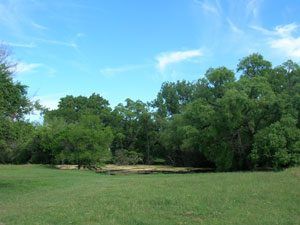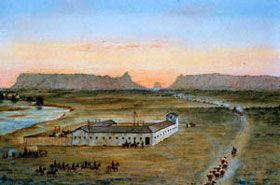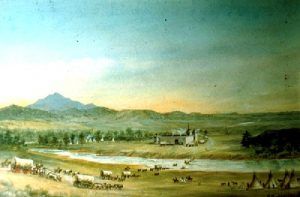
Mud Springs, Nebraska
The Battle of Mud Springs took place in Nebraska from February 4 through the 6th between the U.S. Army and the Lakota Sioux, Cheyenne, and Arapaho tribes.
After the Sand Creek Massacre, which occurred in Colorado on November 29, 1864, the Sioux, Cheyenne, and Arapaho decided to move northward into Wyoming’s more-isolated Powder River country. However, many of the warriors would take their vengeance for the earlier massacre along the way.
Raiding along the South Platte River, the Battle of Julesburg, Colorado was fought on February 2, 1865, and the next day, the warriors burned a telegraph station on Lodgepole Creek in Nebraska.
On February 4, 1865, an advance party of warriors appeared at Mud Springs, a stage and telegraph station. Behind the sod and log walls of the station were 14 men, including nine soldiers. The warriors stole 18 horses and a large herd of cattle. In the meantime, the telegraph operator was sending messages to Fort Mitchell, Nebraska, 55 miles west, and Fort Laramie, Wyoming, 105 miles west.

Fort Mitchell, Nebraska by William Henry Jackson
After an all-night ride from Fort Mitchell, Lieutenant William Ellsworth and 36 men reached Mud Springs. Just a short time later, some 500-1000 warriors also arrived. Sixteen soldiers occupied a nearby bluff to keep the Indians from getting too close, but suffering heavy attacks by the warriors, they retreated to the station, with one man dead and another wounded. The soldiers opened the corrals that afternoon and let their horses run loose, which dispersed the Indians as they attempted to capture the animals. The warriors then retreated to their camp about 10 miles east of the station.
Early the following day, on February 6, Colonel William O. Collins and his troops arrived from Fort Laramie, bringing the total at the station up to 170 men. The exhausted Wyoming soldiers took shelter in a makeshift corral formed by four wagons. However, the warriors soon returned, showering the men and horses with arrows. Two groups of soldiers were sent out to drive the Indians back, which was successful. Fifty additional troops arrived that evening along with a 12-pounder mountain howitzer. Colonel Collins prepared to take the offensive the next day, February 7, but the Indians did not return. Casualties of the soldiers were one man dead and eight wounded. Colonel Collins estimated the Indian casualties at 30; however, Cheyenne warrior, George Bent, said no Indians were killed.
In the meantime, the Sioux, Cheyenne, and Arapaho camp, which comprised up to 5,000 men, women, and children, continued their trek northward. But, Colonel Collins and his troops would pursue them, resulting in the Battle of Rush Creek on February 8th and 9th.

Old Fort Laramie
The battle was inconclusive, although the Indians succeeded in capturing some Army horses and a herd of several hundred cattle. Mud Springs is located eight miles northwest of Dalton, Nebraska, and is a National Historic Site today.
© Kathy Alexander/Legends of America, updated April 2022.
Also See:
Indian Wars, Battles & Massacres
Indian Wars of the Frontier West by Emerson Hough
